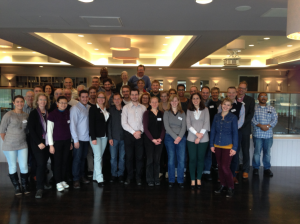Publishable summary
Fodder legumes have two advantages over other forage plants. They are high in protein and require little or no nitrogen fertiliser. There are other benefits which legumes can offer. Some, like sainfoin and birdsfoot trefoil, contain ‘bioactive’ constituents that optimise protein use in ruminant nutrition, reduce methane gas emissions, control parasitic worms and improve the quality of foods from ruminants. LegumePlus aims to carry out research in these areas.
This report describes the progress of LegumePlus in 2012 and 2013. It summarises the contributions by 14 fellows, 10 full partners, 5 associated partners and a visiting researcher from 6 European countries and from New Zealand.
Project objectives
LegumePlus will provide training for 14 Early Stage Researchers and 2 Experienced Researchers in professional skills in the context of research on bioactive legumes. The objectives and contributions of LegumePlus cover the mechanisms of bioactive constituents in forage legumes in order to
- Achieve better protein use efficiency (Objective 1)
- Reduce methane gas production (Objective 2);
- Enhance the quality of milk and meat products (Objective 3);
- Inhibit parasitic worms (Objective 4);
- Integrate and generate knowledge to improve selected European legumes (Objective 5)
This research will develop new targets for plant breeders to develop improved legume cultivars.
Description of work performed and main results
Research is progressing as planned. All field experiments were established successfully; two fields had to be replanted due to bad weather. Fields containing sainfoin, birdsfoot trefoil and red clover are now being used for agronomic evaluations, molecular marker developments, in vitro studies and feeding trials in order to assess their beneficial effects on animal health and nutrition and on environmental emissions.
In Workpackage 1, fields were planted with three forage legumes, sainfoin, birdsfoot trefoil and red clover. This provided material for ensiling studies and for feeding trials to produce milk, cheese and meat. Animal products were assessed for nutritional quality and also for environmental methane and nitrogen emissions. The silages showed good fermentation quality and were used for in vitro assays and feeding trials. Effects of drying and ensiling on the bioactive tannins were also investigated, as changes might achieve lower protein degradability in the rumen with ensiled compared to fresh material. This could enhance the amount of protein available to the ruminant animal and reduce environmental nitrogen losses.
Workpackage 2 received large quantities of sainfoin from MG2Mix in France for a feeding trial, which examined nematode establishment in young animals by measuring worm burden, female fertility and faecal egg counts. In addition, in vitro effects of contrasting tannins (from Workpackage 3) were tested against four parasitic worm species: Ostertagia ostertagi, Cooperia oncophora, Haemonchus contortus and Trichostrongylus colubriformis larvae. Several fellows collaborated to identify factors of variability in anthelmintic (syn. anti-worm) in vitro assays between laboratories and to write standard operation procedures.
In Workpackage 3, fellows isolated gram quantities of contrasting tannins for their own research and for that of the other fellows. They explored the effects of different storage conditions on the stability of these plant compounds. They developed and optimised thiolytic degradation and mass spectrometric methods in freeze-dried and processed samples in order to improve the detection and quantitation of tannins in different legume species and plant parts (three manuscripts have been submitted in refereed journals). The agronomic field trials (Workpackage 4) provided >800 sainfoin samples for polyphenol screening by the newly established methods. Tannins varied greatly within and between accessions and leaves had more tannins and prodelphinidins than stems. In addition, the effects of pelleting and ensiling on tannin extractability were determined, as this may be linked to their anthelmintic activity.
Workpackage 4 used several sainfoin accessions for agronomic evaluations, phenotyping, genotyping and marker development and includes a segregating mapping population. Most sainfoin plants (86%) survived the harsh winter of 2012. Fellows tested mixtures of 3 sainfoin cultivars with 6 partner species in order to optimise sainfoin establishment and weed suppression. Interestingly, some mixtures produced higher sainfoin yields than single stands. Preliminary data from the first year show that weed suppression is managed successfully by all mixtures. A few herbicides also showed promise for pre-emergence weed control.
The fellows successfully extracted high quality RNA and DNA from several sainfoin lines. The cDNA was sequenced using llumina sequencing technology, >3000 microsatellites were obtained from the transcriptome sequences and primer pairs were designed for amplification of putative simple sequence repeats (SSR). These will be screened and tested for polymorphism to enable characterisation of the genetic diversity in our sainfoin germplasm.
Expected final results and potential impact and use
LegumePlus will be able to report on whether sainfoin, birdsfoot trefoil and red clover cultivars can be used to improve milk, cheese and meat quality and to lower environmental emissions from ruminant production. It will deliver analytical tools that are suitable for the rapid screening of bioactive compounds in plant improvement programmes. It will also establish structure-activity relationships between bioactive tannins and anthelmintic effects. Molecular markers will be developed, which are suitable for the breeding of new European sainfoin cultivars that have better nutritional and anti-worming properties. LegumePlus will publish guidelines on sainfoin cultivation for farmers in Europe.
Socio-economic impact and the wider societal implications of the project so far
LegumePlus has been training 14 young researchers, who are keen to make a contribution to food production and security whilst at the same time reducing its environmental footprint.
Contact: Prof I. Mueller-Harvey (i.mueller-harvey@reading.ac.uk)
Project website: http://legumeplus.eu

